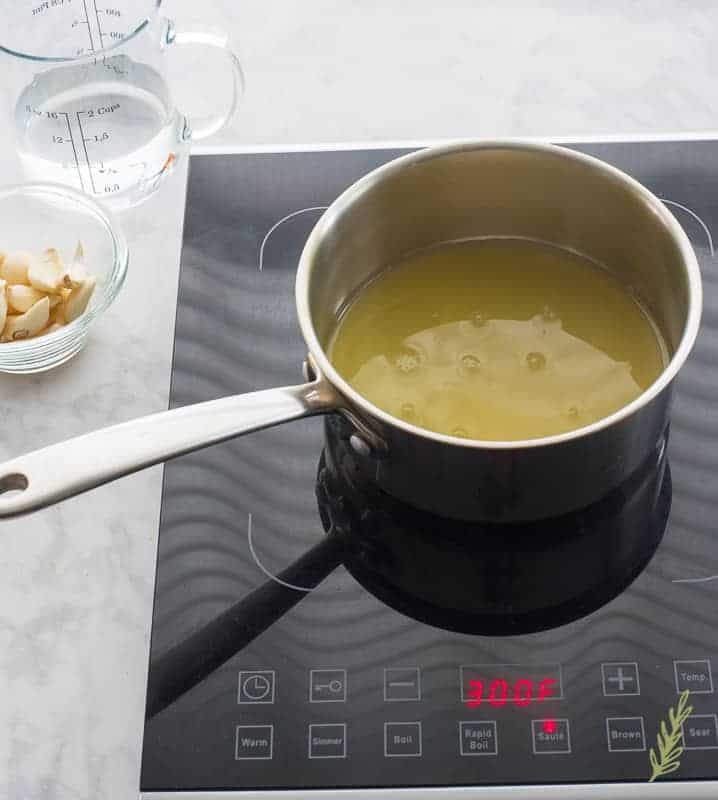
Amba is a decidedly Middle Eastern condiment. I’m not quite sure which culture first produced it; it has origins in Indian and Arabic cuisine. My first foray into Amba was via an Israeli sabich bowl, but the Israelis received it from their Iraqi brethren, so who really knows? If you do, do tell.
Amba is made from very green mangos which have been salted anywhere from a few hours, up to five days. My recipe, while adaptable to your schedule, calls for the full Monty. A full workweek of salting. The result, when coupled with the powerful punch of the warmed spice mixture, is nothing short of indulgence. Yes. A chutney can be indulgent. If you don’t know what a chutney is, think cooked salsa. Some are left chunky, others are pureed. Mine is more sauce than relish, because I typically use it as a coating or as a dip. As always, I leave it to you to decide if you want to puree or not. I recommend it for this recipe just because of the whole spices that are used.


Just as we need a stable base to cut on, we need a stable fruit to cut. To do that, lop off an eighth of an inch slice from the stem end of the mango. This provides a very flat surface to stand the mango up on.


Once the two fleshier pieces of the mango have been removed, you can cut away any excess flesh still remaining on the pit. Discard the pit.

Salt your mango slices and give the fruit a few tosses to ensure it’s coated well. Wrap the bowl tightly in plastic film and store in a sunny area of your kitchen (or any room that gets a lot of sun) for up to five days. You want the mangoes to salt for at least four hours. Obviously, the more time you let them salt, the better the end flavor. Don’t worry about the danger of leaving this out on the counter for such a long period of time. Salting serves many purposes in this recipe. It inhibits the growth of bacteria by pulling out the moisture (water) in the mango slices. This step also encourages the fermentation process by allowing the good bacteria to do their thing. It’s kind of like kimchi…except not.
After the salting period has elapsed (five days later for me), strain your mangoes in a colander. Be sure to save the liquid you strain from them! It’s important.
After salting and straining, it’s important to get those mango slices bone dry. You don’t want a watery Amba because it will bog down the flavors. Lay out your mango slices on a sheet pan lined with paper towels. Place another layer of paper towels over your mango slices and press to absorb any excess moisture. You may think your slices are dry, but they aren’t.
You can proceed one of two ways: you can allow the mango to dry out in the sun for three to four hours, or you can transfer them to a clean sheet pan lined with a silicon mat and bake at a low temp for an hour. I chose the latter. While an hour may seem like forever, you will be spending most of that time preparing your Amba’s sauce.


Once the spices begin to sizzle and pop, add the ground fenugreek, hot paprika, and the ground turmeric. Stir frequently to keep them from scorching.
Once your spice mixture is fragrant (about two to three minutes), add that warm mango liquid. Stir everything together so it’s well-mixed.



Pour a bit of water to thin the mixture out a bit and bring this to a simmer. Allow this to cook for 15 minutes, or until your mango slices are very soft.
If you notice the Amba is becoming too thick, or dry, add more water (a few tablespoons at a time). Once the mango has become soft, remove it from the heat and allow it to cool while you set up a food processor, or blender. Always remember: when blending hot things, you need to vent your appliance’s lid to avoid an explosion. I just remove the plastic plug from the blender’s lid and cover it with a folded towel.
Add the mango mixture to the blender and puree until very smooth. The final sauce should be the consistency of sour cream, or a thin yogurt. If it’s too thick add a small amount of water. Transfer the Amba to glass storage jars (I use Mason jars).
Float two tbsps of corn oil on to the surface of the Amba to mix in just before serving and your first Amba is done!


Amba (Pickled Mango Sauce)
at Sense & EdibilityEquipment Needed:
- blender or food processor
Ingredients
- 5 green mangos peeled and thinly sliced
- 2 1/2 tbsp kosher salt
- 1/2 cup corn or canola oil, divided
- 1 tbsp whole mustard seeds 2 tsp ground if not pureeing
- 1 tbsp coriander seeds 2 tsp ground if not pureeing
- 1/4 cup cumin seeds 2 tbsp ground if not pureeing
- 2 small dried red chili peppers
- 1 tbsp ground fenugreek
- 2 tbsp hot paprika
- 1 tbsp ground turmeric
- 2 tbsp lemon juice
- 10 garlic cloves peeled
- water as needed
Instructions
- Toss sliced mango and salt together in a glass or plastic bowl. Cover the bowl tightly in plastic film and store in a sunny area of your kitchen anywhere from 4 hours to five days.
- After the salting period has elapsed, strain your mangoes in a colander over a clean bowl. Be sure to save the liquid you strain from them!
- Lay out your mango slices on a sheet pan lined with paper towels. Place another layer of paper towels over your mango slices and press to absorb any excess moisture. Allow the mango to dry out in the sun for three to four hours, or transfer them to a clean sheet pan lined with a silicone mat and bake at 170°F for one hour.
- While your mangos are drying, bring the reserved mango juice to a boil. Remove from the heat and keep warm.
- In a large pan heat 1 1/2 tbsp of the corn oil over medium-high heat. Once the oil begins to ripple, add the mustard seeds, coriander, cumin, dried chili peppers. Once the spices begin to sizzle and pop, add the fenugreek, paprika, and turmeric. Stir frequently to keep the mixture from scorching. Once your spices are fragrant (about two to three minutes), add the mango liquid. Stir to combine. Bring this mixture to a boil, then reduce the heat to simmer. Allow this sauce to reduce until it is a thick sauce (tomato sauce consistency).
- Add the dried mango slices to the simmering sauce and stir to combine. Now add the lemon juice and garlic and stir well. Pour a tbsp of water to thin the mixture out and bring to a simmer. Allow this to cook for 15 minutes, or until your mango slices are very soft. If you notice the Amba is becoming too thick, or dry, add more water (a few tablespoons at a time).
- Once the mango has softened, remove the pan from the heat and allow it to cool slightly. Pour the mango mixture into a blender and puree until very smooth. Remember to vent your blender's lid and cover it with a folded towel to prevent mishaps. The final sauce should be the consistency of yogurt. If it's too thick add a small amount of water.
- Transfer the Amba to glass storage jars. Float two tbsps of corn oil on the surface of each jar of Amba to mix in before serving and refrigerate until cool.
- This Amba will keep for up to one month under proper refrigeration.
Notes
-
Prep time is a minimum of 4 hours of salting, max of 5 days.
-
Drying time can be done in a low temp oven (170°F) for 1 hour, or in the sun for 3 to 4 hours.
**This post contains affiliate links. To find out what that means to you, please read my disclosure page**
Need more creative recipes?
Try these:
Puffy Latkes
Tabbouleh (Bulgur-Parsley Salad)


















Hi there!
I salted the mangoes with 2% salt of their weight.
Left them out for 3 days then put them in the fridge for 4 days.
When I opened the jar they smelled a bit alcoholic.
Do you think it is still okay to use them?
That depends. Does it smell sour or unpleasant or sweet and like pickles? If it’s the former, then err on the side of caution and throw them out. Did you use very green mangos? Was the container they were salted in clean and non-metallic? If they develop a white, streaky appearance and an unpleasant smell, chances are they have spoiled instead of dried out.
I tried several recipes on the web, and this was the real thing. Absolutely fantastic. Thank you!
You’re welcome, Tahvo.
This is the best amba recipe in the web. Thank you very much.
My pleasure. Glad you like it.
How much cumin?
It says “1/4 cumin seeds”
1/4 cup?
Sorry about that, Tom! Yes, it’s a 1/4 cup of cumin seeds.